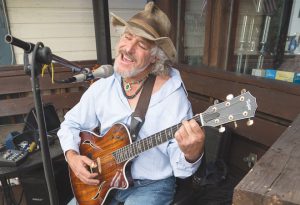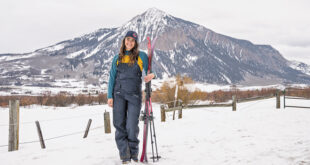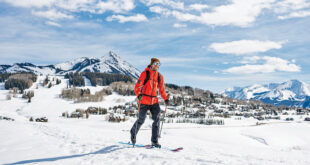Rock Star
by Dawne Belloise
Chuck Grossman’s vocals are smoothly tempered from a lifetime immersed in song. His fingers, calloused from years of playing, seemingly float across his guitar strings, making the difficult progressions look far easier than they are.
But that’s not what makes him a rock star. The Leadville, Colo. native, an extreme rock climber of more than four decades, has more than 200 first ascents.
As a Leadville baby and one of the babies in a study on the effects of high altitude on newborns, Grossman jokes, “I was high since I was a child.” His dad was a mining engineer for Amax’s Climax mine in Leadville, but Chuck points out that he’s not entirely in favor of or against mining.

“If it could be done environmentally responsibly then I’m not against it, but it seldom is.” His mother was a grade school teacher and second-generation Coloradoan. When his parents moved him to south Denver, Littleton, the pavement ended and dirt roads were just beyond their house. Chuck grew up watching the area transition from almost rural to congested shopping malls and subdivisions. But back when he was a kid, the open fields were his playground. Chuck learned to love the outdoors, with skis slapped on as soon as he could stand upright on two legs.
In seventh grade, at 13, Chuck got his first taste of the rush of climbing, following some friends rappelling off mud cliffs in Littleton. “We were using rebar that we took from construction sites as anchors. It’s a miracle any of us survived it,” he muses of the craziness of their actions. But the steep challenge intrigued him and he realized, “I immediately loved climbing and vertical places. It was adventurous with lots of adrenalin, it was being outdoors and in close contact with nature.”
Before he found the thrill of rope climbing, Chuck was scrambling, bouldering and soloing on granite cliffs outside of Evergreen. “I took a 30-foot fall off those cliffs when I was 15 years old and miraculously did not hurt myself. I went out and bought my first rope the very next day and vowed that I would learn how to do it safely.”
Grossman started technical climbing in high school, using gear and learning from books and his mistakes, which, fortunately, weren’t serious enough to keep him off the rock. “I ended up putting up a number of first ascents, not really knowing how difficult they were with nothing to compare them to until I started climbing established routes in the Boulder area. Then I realized how hard some of routes we had done were. The early routes that I had done the first ascents on were hard to protect, meaning, it’s hard to get gear in. There are a lot of flaring cracks (as opposed to parallel cracks which are easier to put gear into) and I learned a lot about protection.”
The summer of 1978, following his high school graduation, he moved to Carbondale so he could have easy access to Glenwood Canyon.
“I had seen that canyon when I was a kid and was very impressed,” he says of the spectacular geology of Glenwood before I-70 was run down the canyon’s middle. Throughout high school, you could find the young teen on the slopes with junior ski patrol at Winter Park. After his stint climbing around Glenwood Canyon, he actually moved to Winter Park to be a ski bum, paying a mere $50 a month rent and living the dream. When winter snows receded, he followed the rock, moving to Estes Park to climb.
Chuck enrolled at his sister’s alma mater in 1980, Western State College (WSC), taking business courses specifically so he could put a climbing school together, but he admitted, “Part of the allure of going to Western was to be able to ski Crested Butte.”
He laughs, recalling the once-popular bumper sticker that touted, “Ski Western State and pick up a diploma in your spare time.” Which is exactly what he did, setting up his schedule to maximize his time on the slopes and on the rock.
“I climbed Taylor Canyon all year because it actually stays pretty nice all winter and when it was too cold, I’d be skiing.” Grossman says he ended up doing a bunch of first ascents in Taylor Canyon and second ascents of Scotty Gilbert’s routes. “Gilbert was doing routes ahead of his time and I gained a lot of respect for him doing several of his routes.”
In an epic climb in 1981 with Jim Newberry (a Cimarron native and climbing legend with first ascents in the Black Canyon), Grossman made an attempt on a new route in the Black Canyon that eventually became known as Astrodog. “Named for the dog we had found at the bottom of the cliff, who chased a chipmunk off the edge. We spent three days on the wall, climbing seriously overhanging rock. It was at the end of the third day, we were just approaching the first ledge, a thousand feet up, where we were going to spend the night, when rockfall occurred from a thousand feet above us. It rained refrigerator-sized blocks of rocks, hitting the ledge above us that we were going for and bouncing over and around us. If we had been on this ledge, I wouldn’t be telling this story. We set up a hanging tent below the ledge and continuously through the night heard rockfall that terrified us.” After that sleepless night, they decided wisely to bail and not attempt the final part of the climb.
Chuck guided climbing for Wind River Mountain Guides of Pinedale, Wyo., during the summers, and he recalls how difficult is was after the terrifying rockfall experience in the Black Canyon, but he also felt it was somewhat therapeutic.
He graduated from WSC in 1984 with a bachelor of arts degree in business administration and moved to Fort Collins.
Recalling his climb alone on the Diamond on Long’s Peak, a four-day ascent of extreme difficulty, he says, “It was one of the highlights of my climbing career.” He explains that when you rope solo, you climb everything twice because you have to go back down the route you just ascended to haul up your gear. He slept in a hammock suspended on the wall for those nights. “It was one of the hardest and longest routes on the wall at the time.”
Chuck’s first love, from a young age, was music. “My first instrument was a ukulele at the age of five and I’ve been playing guitar since I was seven. I studied classical and finger-picking styles under a master from the time I was 11 to 15 years old. I did my first gig at 16 years old and was playing in bars in all the ski towns from the time I was 18.”
He chortles that he’s still playing bars and ski towns. In high school, he was a prolific song writer. While attending WSC, Chuck played local Gunnison and Crested Butte venues, doing his blend of folk rock, blues, and country covers as well as his originals.
In Fort Collins, Chuck had ventured into a day job managing a Walgreen’s, an unlikely match for a working musician with a taste for adventure. “One day there was a power outage at the store and I pulled out my guitar and started playing for my employees. A customer came in, heard me playing and asked me what the hell I was doing managing a Walgreen’s if I could play like that. He gave me a book called Kiss the Rat Race Goodbye, stories of people who quit their regular jobs and pursued creative careers—writers, artists, and musicians. Two weeks later I gave my notice and booked a round trip ticket to Europe,” because, he says, he had heard that Europeans loved American music. “I spent the majority of the year there playing in a series of Irish pubs throughout Germany.”
At the end of his tour of Euro pubs, he returned to the U.S. in 1988, and it was while jamming at the Mountain Man Rendezvous up Washington Gulch that he met Monique Nyskens. They married shortly after and moved frequently to follow work and dreams—Redstone, Nederland, Eldora and in the early ‘90s, they moved to Monique’s homeland, Holland, living in a 16th-century farmhouse near the borders of Belgium and Germany. Chuck was playing finger-style blues gigs in the Netherlands, Germany and Belgium.
A year later, they returned once again to Eldora where Chuck recorded his first CD, Burnin’ Blue, released in 1999. They toured the west coast and into Texas promoting his CD, living out of a camper bus, and realizing that trying to make a living playing music on the road was difficult, so they returned to Eldora in 2000. The couple decided to go their separate ways the following year and Chuck bought a house in Leadville, closer to the better-paying gigs in the Vail valley. His talent scored him a steady show at the Ritz-Carlton at Beaver Creek, and he put a thousand miles a week on his car between various ski towns. He was later booked at the new Lake Tahoe Ritz-Carlton, doing shows there for a couple of years.
When Chuck’s father was diagnosed with Parkinson’s in 2012, he moved back to Denver to help care for him, doing gigs at the Denver Ritz-Carlton and other venues for the next several years. His father passed away in early 2013.
Chuck felt somewhat directionless and homeless, and went traveling throughout Colorado. He rekindled his interest in climbing through his statewide sojourn, winding up in Paonia where a life-altering, serious car accident served as a wake-up call. “It scared me and made me realize how tenuous life can be.” With most of his gigs in Crested Butte, he decided to relocate in 2014.
Recently Chuck recorded a couple of songs for the legendary mountaineer Jeff Lowe’s Metanoia, a film recounting his epic solo ascent of the Eiger and his subsequent battle with a debilitating disease, a form of ALS. The movie has won 17 international film festival awards. Grossman has landed steady gigs and regular shows in many venues and events up and down the valley.
He’s one of the new residents in Anthracite Place, the brand new 30-unit town housing, which will allow him to continue living in Crested Butte as a musical artist. He says he loves his chosen community for many reasons—its outdoor-oriented and healthy lifestyle, and the opportunity to continue climbing and skiing—and he’s grateful for the fact that, “This town has a lot of live music for being a small town.”
 The Crested Butte News Serving the Gunnison Valley since 1999
The Crested Butte News Serving the Gunnison Valley since 1999


